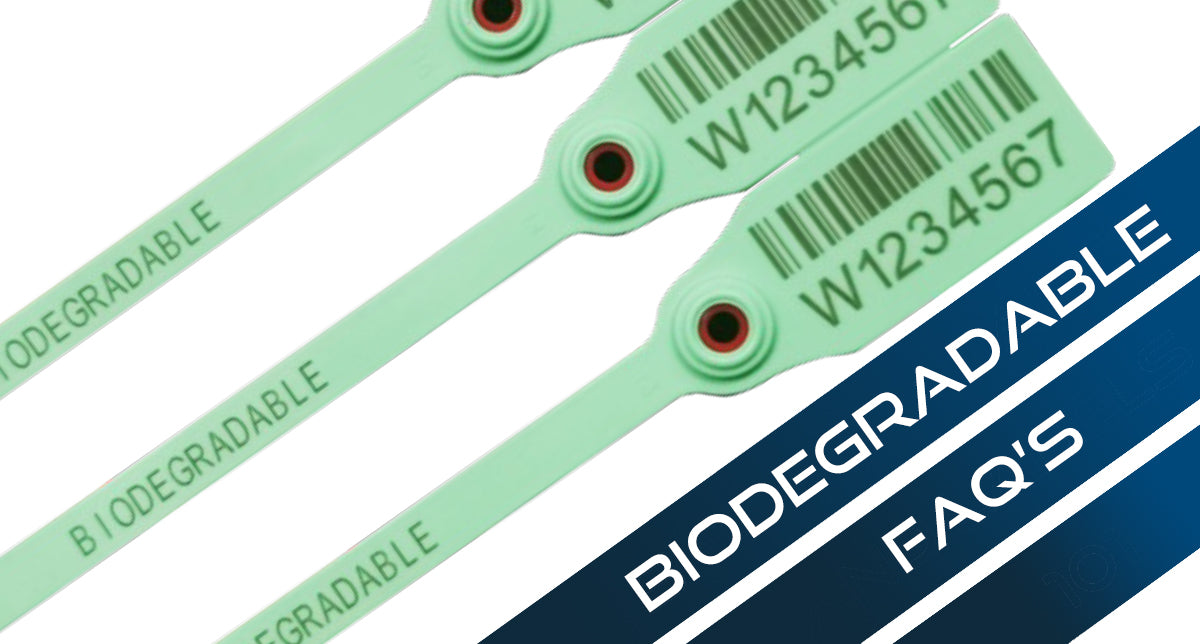Your Cart is empty
As Australia's largest provider of Biodegradable Security Seals, we want to provide our customers with the assurance and peace of mind that our biodegradable security seals are indeed what is claims - BIODEGRADABLE.
There has been a lot of confusion between biodegradability, compostability and oxo-degradability. In this blog post, Seals HQ will explain the difference between these three processes, and why you should trust Seals HQ's biodegradable security seals.
1) WHAT'S THE DIFFERENCE?

BIODEGRADABLE PLASTICS: Biodegradable plastics are a relatively small subset of bioplastics which can be converted into water, carbon dioxide and bio-mass over time with the help of micro-organisms. This process is called biodegradation.
COMPOSTABLE PLASTICS: Compostable plastics are those plastics which have been tested and certified by a third party to adhere to international standards such as ASTM D6400 (in the US) or EN13432 (in Europe) for biodegradation in an industrial composting facility environment.
OXO-DEGRADABLE PLASTICS: They are neither a bioplastic or a biodegradable plastic, but rather a conventional plastic mixed with an additive in order to imitate biodegradation. Oxo-degradable plastics quickly fragment into smaller and smaller pieces, called microplastics, but don’t break down at a molecular or polymer level. The resulting microplastics are left in the environment indefinitely until they eventually fully break down.
Seals HQ Biodegradable Security Seals are 100% biodegradable. This means that once our security seals are disposed in landfills, microbes digest it and the plastic disappears (that’s why we get the byproducts of biogas and water).
Oxo-degradable (or now marketed as oxo-biodegradable) are not biodegradable. The claims made by these oxo manufacturers is that the plastic will break and break and break again, eventually breaking into nothing. However, we know that this is not true as we have already seen reports that microplastics have been found in human lungs.
2) WHAT'S THE TECHNOLOGY BEHIND SEAL HQ'S BIODEGRADABLE SECURITY SEALS?
Seals HQ's Biodegradable Security Seals uses a very special additive called BioSphere to encourage natural biodegradation in our security seals. Watch this video below to find out more about BioSphere:
Now that you understand how BioSphere works, you might be interested to know that Seals HQ Biodegradable Security Seals contain 1% of BioSphere additive. In some cases, the concentration can be increased upon request by the customer. This is usually done to encourage a faster rate of biodegradation.
3) WHAT ARE THE CONDITIONS FOR BIODEGRADATION?
The only requirement for biodegradation to occur is the presence of microbes. In the video above, you learnt that the BioSphere additive attracts over 600 different types of microbes.
Seals HQ's Biodegradable Security Seals are designed to biodegrade in both aerobic (oxygen rich i.e. compost) and anaerobic (oxygen starved i.e. landfill) environments. Temperature also plays an important role in encouraging biodegradation.
4) WHAT ARE THE BY-PRODUCTS OF BIODEGRADATION?
Another question we usually get is the by-product of biodegradation. When biodegradation occurs, the by-products are a combination of biogas (Carbon Dioxide and Methane) and water.
Methane gas is harmful to the environment at high concentrations. However, Landfills across Australia are required to capture the biogas in order to avoid paying the Carbon Emission Tax. The Australian Government also offers an Emissions Reduction Fund to encourage landfill operators to install equipment to capture biogas. Around 130 landfills in Australia are capturing methane and using it to generate electricity.
5) DO SEAL HQ'S BIODEGRADABLE SECURITY SEALS MEET AUSTRALIAN STANDARD AS5810:2010 OR AS4736:2006?
One of the main requirements is minimum 90% biodegradation within 180 days in compost (AS4736:2006) or 12 months in home compost (AS5810:2010). Seals HQ's Biodegradable Security Seals are compostable, but not at the rate required to fulfil either standards.
6) SHOULD YOU STILL CONSIDER BIODEGRADABLE SECURITY SEALS?
The answer is ABSOLUTELY YES!! Although the Seals HQ Biodegradable Security Seals can't meet the rate of biodegradation required in AS4736:2006 and AS5810:2010, evidence of biodegradation still enforces the fact that this is an environmentally friendly security seal. Comparing with conventional security seals which do not degrade at all, Seals HQ Biodegradable Security Seals will completely degrade in years.
7) ISO14021:2018 ENVIRONMENTAL LABELS AND DECLARATIONS - SELF DECLARED
It is also noted that according to Australian Standard ISO14021:2018, Environmental Labels and Declarations – Self Declared, it is stated in the appendix that ASTM D5511 (which is the test standard we use to determine biodegradability) is an acceptable standard for self-declaration.
If you have any other questions regarding Seals HQ's Biodegradable Security Seals, please contact us using one of the methods below:
PHONE: 1300 920 778
EMAIL: sales@sealshq.com.au
WEB: https://www.sealshq.com.au


